 |
|
Biography
Early childhood
Sri Balak Yogeshwar Maharaj was born on July 30th 1967 around
midnight as the youngest son of
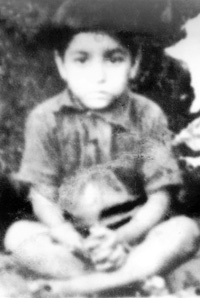 five
children nearby a town called “Pouni” in the state of Jammu &
Kashmir which is situated in the North-Western part of India
towards the border of Pakistan. five
children nearby a town called “Pouni” in the state of Jammu &
Kashmir which is situated in the North-Western part of India
towards the border of Pakistan.
He grew up in a tiny remote village named “Sadhini”, his parents
earning their livelihood by agricultural means. During his
childhood, he was lovingly called “Yoga”, and he used to
attentively listen to the stories from the Bhagavat Purana
[ancient Vedic scripture also known as “Srimad Bhagavatam”] such
as the stories of Dhruva Maharaj and Prahlad Maharaj told by his
mother.
Already in his early age, he could sense that his life is not
going to be an ordinary one. A close childhood friend remembers,
“Yoga once jokingly told me that either he was going to become a
big sadhu [saint], or otherwise he was going to become
a big gunda [dacoit].”
Maharaj’s family followed one
powerful saint called “Dhudahari Baba” who used to perform
havanas [Vedic fire sacrifices] in remote mountain areas in
which the local farmers would participate. In this way, Maharaj
already got some saintly association at a tender age.
Leaving home
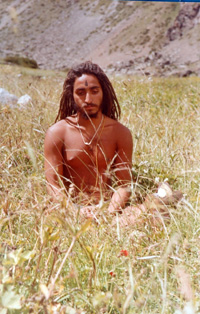 This
sadhu-sanga [association with a saint] left a
tremendous impact on his consciousness, so much so that when
Dhudahari Baba passed away in 1984, Balak Yogeshwar Maharaj
decided to leave home and take to the lifestyle of a traveling
mendicant. There was no objection from his family’s side when he
retired from home since they understood his burning desire to
discover God. This
sadhu-sanga [association with a saint] left a
tremendous impact on his consciousness, so much so that when
Dhudahari Baba passed away in 1984, Balak Yogeshwar Maharaj
decided to leave home and take to the lifestyle of a traveling
mendicant. There was no objection from his family’s side when he
retired from home since they understood his burning desire to
discover God.
First of all, he travelled to Haridwar where he was staying at
the ashram [saintly community] of Dhudahari Baba who had just
left this world. There, he was taking care of the goshala
[service to cows] for one year continuously.
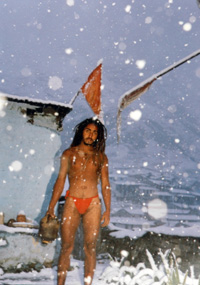 After
that, he decided to leave for Badrinath, and that’s where his
actual tapasya [renunciation or hard penance] started.
For approximately four to five years, Maharaj didn’t meet anyone
and followed a strict mauna-vratta [a vow of silence].
No-one clearly knows what kind of practices Maharaj used to
follow during those years, but it was observed that he spent a
lot of time on the banks of the Alakananda river. Maharaj
recalls that he was intensely searching for God, but that his
path somehow was not yet clearly chalked out at that time. After
that, he decided to leave for Badrinath, and that’s where his
actual tapasya [renunciation or hard penance] started.
For approximately four to five years, Maharaj didn’t meet anyone
and followed a strict mauna-vratta [a vow of silence].
No-one clearly knows what kind of practices Maharaj used to
follow during those years, but it was observed that he spent a
lot of time on the banks of the Alakananda river. Maharaj
recalls that he was intensely searching for God, but that his
path somehow was not yet clearly chalked out at that time.
Meeting his spiritual master
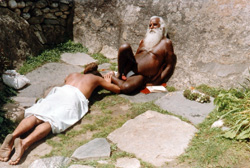 The
main turn in Balak Yogeshwar Maharaj’s life happened when he met
his diksa-guru [initiating spiritual master] Sri
Paramanand Avadhutji Maharaj in the Himalayas. Balak Yogeshwar
Maharaj spent the following five years in the ashram
[saintly community] of his guru [spiritual teacher] and
very dedicatedly served him although Avadhutji Maharaj was not
eager to accept anyone’s menial service and besides that, he was
not at all talk-active. However, pleased by the service rendered
by his disciple, Avadhutji Maharaj initiated Balak Yogeshwar
Maharaj into various powerful mantras [prayers, hymns]
and taught him the art of kriya-yoga [a meditational
practise]. The
main turn in Balak Yogeshwar Maharaj’s life happened when he met
his diksa-guru [initiating spiritual master] Sri
Paramanand Avadhutji Maharaj in the Himalayas. Balak Yogeshwar
Maharaj spent the following five years in the ashram
[saintly community] of his guru [spiritual teacher] and
very dedicatedly served him although Avadhutji Maharaj was not
eager to accept anyone’s menial service and besides that, he was
not at all talk-active. However, pleased by the service rendered
by his disciple, Avadhutji Maharaj initiated Balak Yogeshwar
Maharaj into various powerful mantras [prayers, hymns]
and taught him the art of kriya-yoga [a meditational
practise].
Exploring the Himalayas
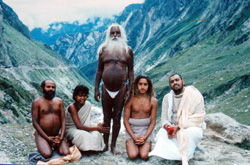 One
day, Balak Yogeshwar Maharaj heard some sadhus [saintly
mendicants] talking about a remote place in the Himalayas called
“Satopanth” which is covered by glaciers and snow and quite hard
to reach. Having gotten curious, he approached his guru and
asked him for permission to visit that hidden place. After
obtaining the permission of his spiritual master, he searched
out for that place and stayed at Satopanth for about four days.
Thereafter, he returned back to the ashram of his guru. One
day, Balak Yogeshwar Maharaj heard some sadhus [saintly
mendicants] talking about a remote place in the Himalayas called
“Satopanth” which is covered by glaciers and snow and quite hard
to reach. Having gotten curious, he approached his guru and
asked him for permission to visit that hidden place. After
obtaining the permission of his spiritual master, he searched
out for that place and stayed at Satopanth for about four days.
Thereafter, he returned back to the ashram of his guru.
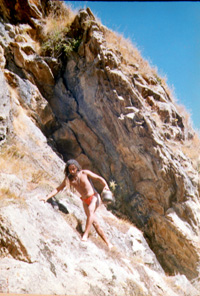 After
some days, his guru asked him whether he had visited
Satopanth. Being pleased with his disciples’ effort, Avadhutji
Maharaj blessed his shishya [disciple] with an
extremely rare and powerful mantra upon receiving which
Maharaj immediately headed towards Haridwar and took bath at the
Hari-ki pauri ghat [sacred bathing spot at the river
Ganges in Haridwar]. As an act of severe penance and humility,
Maharaj then started a dandavat-parikrama
[crawling-like pilgrimage] back towards Satopanth which he had
previously visited. After
some days, his guru asked him whether he had visited
Satopanth. Being pleased with his disciples’ effort, Avadhutji
Maharaj blessed his shishya [disciple] with an
extremely rare and powerful mantra upon receiving which
Maharaj immediately headed towards Haridwar and took bath at the
Hari-ki pauri ghat [sacred bathing spot at the river
Ganges in Haridwar]. As an act of severe penance and humility,
Maharaj then started a dandavat-parikrama
[crawling-like pilgrimage] back towards Satopanth which he had
previously visited.
When he reached Satopanth, he started meditating in the mental
presence of his spiritual teacher who had bestowed these
powerful mantras upon him. By the grace of God, Maharaj was then
able to dive into a deep meditational trance in which he
received various divine instructions. One of the significant
revelations he had during the weeks he stayed at Satopanth
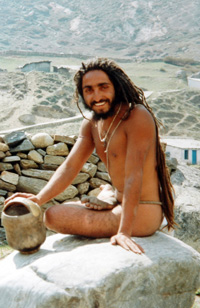 was
that he should travel all over the country and perform
havana [Vedic fire sacrifices] and get the people to chant
God’s sacred names. was
that he should travel all over the country and perform
havana [Vedic fire sacrifices] and get the people to chant
God’s sacred names.
After this incident, Maharaj regularly visited Satopanth and
would stay there for approximately two weeks at one stretch. He
had also been seen spending time at Swarga Rohini (which lies
even beyond Satopanth), as well as in a cave at Nilkanth which
is situated behind the big temple in Badrinath near a crossing
which is known as “Kaak Chowk”.
Accepting more responsibilities
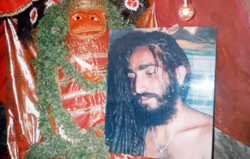 At Kaak Chowk, an ancient Hanuman-Mandir has been situated since
time immemorial of which Balak Yogeshwar Maharaj became the
mahant [spiritual care taker] by the desire of the
pandits [the learned priest class of society] and the local
people of Badrinath in 1990. Furthermore, he has been counted as
the youngest Mahamandaleshwar [order of renunciates
founded by Srila Shankaracarya around 800 A.D.] of the entire
country, i.e. India. At Kaak Chowk, an ancient Hanuman-Mandir has been situated since
time immemorial of which Balak Yogeshwar Maharaj became the
mahant [spiritual care taker] by the desire of the
pandits [the learned priest class of society] and the local
people of Badrinath in 1990. Furthermore, he has been counted as
the youngest Mahamandaleshwar [order of renunciates
founded by Srila Shankaracarya around 800 A.D.] of the entire
country, i.e. India.
How Thakurji came into Maharaj’s life
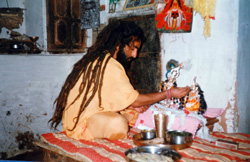 Around
this time in 1990, an elderly person in the holy place “Radhakund”
(Dist. Mathura, Uttar Pradesh) had a dream that he should
deliver some Radha-Krishna murtis [sacred statues] to a
very young sadhu (i.e. Balak Yogeshwar Maharaj) in
Badrinath. Stirred up by this dream, that elderly man made out
the whereabouts of the murtis Around
this time in 1990, an elderly person in the holy place “Radhakund”
(Dist. Mathura, Uttar Pradesh) had a dream that he should
deliver some Radha-Krishna murtis [sacred statues] to a
very young sadhu (i.e. Balak Yogeshwar Maharaj) in
Badrinath. Stirred up by this dream, that elderly man made out
the whereabouts of the murtis
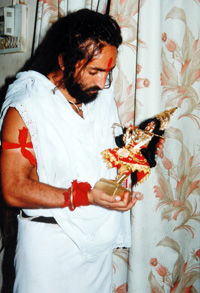 to
be delivered and upon excavating them, he started his journey
towards Badrinath where he was searching for that young saint
whom he initially could not find. The elderly man then again had
a dream in which he was able to recognize Maharaj’s face, and by
some divine arrangement they both met at the Badrinath temple
the very next day. That’s the moment Balak Yogeshwar Maharaj
received his beloved Radha-Krishna Deities of which he is very
fond. Since his Deities came from that holy place Radhakund,
Maharaj started visiting Radhakund occasionally in the year
1993, and he used to stay at that old man’s house who had
delivered the Radha-Krishna statues to him. to
be delivered and upon excavating them, he started his journey
towards Badrinath where he was searching for that young saint
whom he initially could not find. The elderly man then again had
a dream in which he was able to recognize Maharaj’s face, and by
some divine arrangement they both met at the Badrinath temple
the very next day. That’s the moment Balak Yogeshwar Maharaj
received his beloved Radha-Krishna Deities of which he is very
fond. Since his Deities came from that holy place Radhakund,
Maharaj started visiting Radhakund occasionally in the year
1993, and he used to stay at that old man’s house who had
delivered the Radha-Krishna statues to him.
Acceptance of disciples
It was a bit before this period, around 1991, that Maharaj
started accepting his first couple of disciples. His first
student was named “Mr. Prashant” who was a resident of Badrinath.
When Maharaj stayed in a cave near the main temple of Badrinath,
Mr. Prashant used to serve Maharaj some milk and repeatedly
requested initiation from him. Balak Yogeshwar Maharaj’s
initiating spiritual master, Avadhutji Maharaj, had previously
instructed Maharaj to accept disciples in order to show the
common people the proper path of spiritual life. Following the
order of his master, Balak Yogeshwar Maharaj gradually started
accepting disciples.
A call back from Jammu
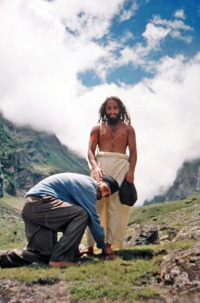 An
important key role in Maharaj’s life played his cousin brother
Davinder Singh (also known as “Pintu”) who came to visit Maharaj
in Badrinath in 1995, having lost touch with him since childhood
at the time Maharaj left home in 1984. Impressed by Maharaj’s
present way of life and tremendous spiritual power, Pintu –
although being Maharaj’s cousin brother – decided to take
shelter of Balak Yogeshwar Maharaj’s and accept him as his
spiritual guide. Pintu was dissatisfied with the kind of
so-called sadhus which used to wander around his
native place Jammu at that time, and that’s why he urged Maharaj
to return to Jammu and take up preaching there for the benefit
of the general people. Initially, Maharaj was rather hesitant to
return to Jammu, but in due course of time, more and more people
from Jammu came to visit Maharaj in Badrinath and pleaded him to
come back. An
important key role in Maharaj’s life played his cousin brother
Davinder Singh (also known as “Pintu”) who came to visit Maharaj
in Badrinath in 1995, having lost touch with him since childhood
at the time Maharaj left home in 1984. Impressed by Maharaj’s
present way of life and tremendous spiritual power, Pintu –
although being Maharaj’s cousin brother – decided to take
shelter of Balak Yogeshwar Maharaj’s and accept him as his
spiritual guide. Pintu was dissatisfied with the kind of
so-called sadhus which used to wander around his
native place Jammu at that time, and that’s why he urged Maharaj
to return to Jammu and take up preaching there for the benefit
of the general people. Initially, Maharaj was rather hesitant to
return to Jammu, but in due course of time, more and more people
from Jammu came to visit Maharaj in Badrinath and pleaded him to
come back.
The passing of his spiritual master
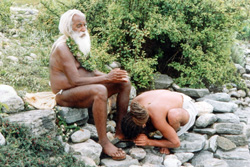 Another
significant incident deeply impacted Maharaj’s life, namely the
passing away of his gurudeva Sri Paramanand Avadhutji Maharaj in
1996. Avadhutji Maharaj passed away in Rishikesh during his
meditational practice, sitting in padma-asana
[crossed-legged sitting posture]. For quite some time, no-one
realized that he had passed away since everyone was thinking
that he had entered some meditational trance [also known as “samadhi”].
For about one year, Balak Yogeshwar Maharaj was emotionally
deeply stirred up and felt bereft of his beloved teacher. Another
significant incident deeply impacted Maharaj’s life, namely the
passing away of his gurudeva Sri Paramanand Avadhutji Maharaj in
1996. Avadhutji Maharaj passed away in Rishikesh during his
meditational practice, sitting in padma-asana
[crossed-legged sitting posture]. For quite some time, no-one
realized that he had passed away since everyone was thinking
that he had entered some meditational trance [also known as “samadhi”].
For about one year, Balak Yogeshwar Maharaj was emotionally
deeply stirred up and felt bereft of his beloved teacher.
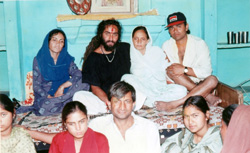 As
previously mentioned, the visitors from Jammu gradually
increased in Maharaj’s hermitage in Badrinath and it so happened
that some of them started assembling at their homes in Jammu and
occasionally hold sat-sanga programs [spiritual home
programs], being inspired by Maharaj’s association and
instructions. In 2000, Maharaj sent his beloved Radha-Krishna
Deities to Jammu where They stay up to this day and where They
bless the sat-sanga programs of the local followers of
Maharaj with Their divine presence. As
previously mentioned, the visitors from Jammu gradually
increased in Maharaj’s hermitage in Badrinath and it so happened
that some of them started assembling at their homes in Jammu and
occasionally hold sat-sanga programs [spiritual home
programs], being inspired by Maharaj’s association and
instructions. In 2000, Maharaj sent his beloved Radha-Krishna
Deities to Jammu where They stay up to this day and where They
bless the sat-sanga programs of the local followers of
Maharaj with Their divine presence.
Maharaj returns to Jammu
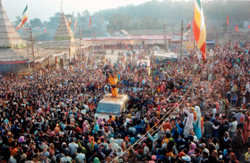 Finally
in 2003, Maharaj reluctantly returned to Jammu where he
performed a huge yajna [Vedic fire sacrifice] in the
dried-up riverbed of Jammu [also known as “Jammu Tawi”] which
was attended by not less than 10 lakhs people [approx.
1,000,000 people]. This event drew a lot of attention from
different walks of society in Jammu and even created headlines
in the media. Finally
in 2003, Maharaj reluctantly returned to Jammu where he
performed a huge yajna [Vedic fire sacrifice] in the
dried-up riverbed of Jammu [also known as “Jammu Tawi”] which
was attended by not less than 10 lakhs people [approx.
1,000,000 people]. This event drew a lot of attention from
different walks of society in Jammu and even created headlines
in the media.
World peace project
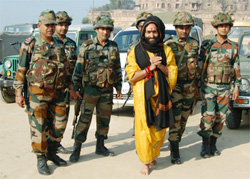 In
2006, Balak Yogeshwar Maharaj started performing fire sacrifices
in Kargil, i.e. Drass – a place where the war between India and
Pakistan was fought, and which happens to be a very ancient
historical place. Since a lot of Indian martyrs lost their lives
during the Kargil war, Maharaj took it as an opportunity to pay
respect to the departed souls and to make an extended statement
by proclaiming world peace in general. Maharaj in this way also
got a new name - Sainik Baba, which means as much as
“The father of the soldiers”. In
2006, Balak Yogeshwar Maharaj started performing fire sacrifices
in Kargil, i.e. Drass – a place where the war between India and
Pakistan was fought, and which happens to be a very ancient
historical place. Since a lot of Indian martyrs lost their lives
during the Kargil war, Maharaj took it as an opportunity to pay
respect to the departed souls and to make an extended statement
by proclaiming world peace in general. Maharaj in this way also
got a new name - Sainik Baba, which means as much as
“The father of the soldiers”.
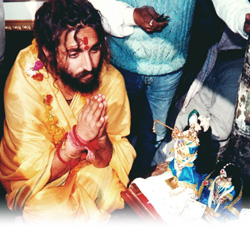 Up
to this day, Maharaj is traveling all over India and is
performing havana [sacred fire ceremonies] in various
places. At this time, he has about 50,000 initiated disciples
which constitute the core of the huge followership he has. He
has never travelled abroad (apart from Nepal), although once in
2005 he was supposed to travel to the USA. Standing in the queue
at the airport to check in his luggage, he all of a sudden felt
separation from his Radha-Krishna Deities so much so that he
decided not to fly off, but to return to Jammu in order to
celebrate Janmastami [Lord Krishna’s appearance day] there. Up
to this day, Maharaj is traveling all over India and is
performing havana [sacred fire ceremonies] in various
places. At this time, he has about 50,000 initiated disciples
which constitute the core of the huge followership he has. He
has never travelled abroad (apart from Nepal), although once in
2005 he was supposed to travel to the USA. Standing in the queue
at the airport to check in his luggage, he all of a sudden felt
separation from his Radha-Krishna Deities so much so that he
decided not to fly off, but to return to Jammu in order to
celebrate Janmastami [Lord Krishna’s appearance day] there.
In conclusion, it can be said that Sri Balak Yogeswhar Maharaj
is a very extraordinary and blessed saint who is inspiring
thousands of people on their spiritual sojourn. He’s a shining
example of dedication to the Lord and whoever has met Maharaj
will not be able to ever forget his gentle nature and his
kindness.
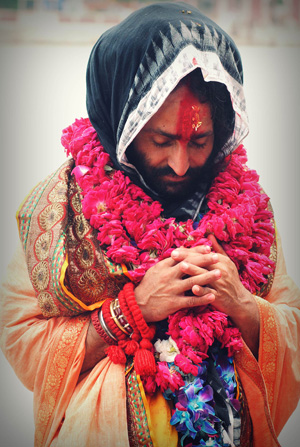
HARI
OM TAT SAT!
|
